Sunday, July 10, 2005
Delightful Islands of Lakshadweep
Trip duration from Cochi - 1.5 hours
Number of days - 4 days/3 nights
Cost of flight - Rs. 8000/person (5000 if booked early)
Cost of accomodation/food - Rs. 13,000 per person
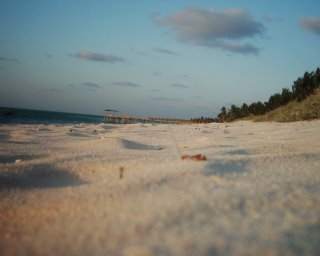
Activities:
Snorkelling - Rs. 50 for mask and fins
Scuba - Rs. 3000 per dive
Windsurfing - ??
Water skiing - 1-hour free
Kayaking - included
3-islands trip - included
1 fishing trip - included
TOTAL (2 people) - Rs. 42,000 ($1,200 CDN)
Cochin (Feb. 20, 2005) - The powerful noon-day sun was vaporizing the asphalt in Cochin as the plump ambassador taxi dropped us off at the airport. Cochin airport itself is an architectural and organizational rarity in India - spacious, clean, and no hecklers or beggars. The taxi driver was well-mannered and gratefully accepted the Rs. 500 fare and tip for the drive from Ernakulam.
I should not call this a road trip, but there was no way to get there by road. We chose a 12-
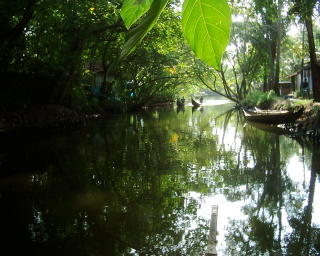 seater Air India flight from Cochin. The cramped confines of the twin-engine, propeller driven plane encouraged close contact with our 8 fellow passengers. There were two newly married couples who were going to be with us at the resort on Agatti, a government officer headed for Kadmat, and three Britishers going to the island resort of Bangaram, the island next to Agatti.
seater Air India flight from Cochin. The cramped confines of the twin-engine, propeller driven plane encouraged close contact with our 8 fellow passengers. There were two newly married couples who were going to be with us at the resort on Agatti, a government officer headed for Kadmat, and three Britishers going to the island resort of Bangaram, the island next to Agatti.Soon the plane gently rose above the verdant Keralite landscape of coconut palms and serpentine backwaters, and headed due west over a sparkling Arabian sea. In one hour we were seeing small outcrops of land and coral scattered down below, starting with Pittu which was probably a 100 square foot piece of sand. Eventually Agatti, the narrow 11-km island with the air-strip at one end stretched into view below us and the plane descended gracefully and taxied to the small concrete structure at one end of the lone runway.
It felt like we were in a Tintin comic book!

We were well received by the sparse ground staff and a representative from Agatti Beach Resort was on hand to help us gather up our luggage and walk to the gates of the beach resort located 100 meter down the single concrete road that ran the entire length of the island.
The beach resort consisted of a reception center that housed a desk and the obligatory gift shop adjacent to it. The dining area was the next building with an open verandha and a single room with a few tables and chairs. Beyond this was the kitchen.
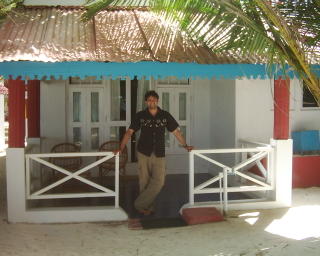 Spread out closer to the beach were a row of small cottages to the left and a row of air-conditioned rooms further to the right. In all very simple, but with a relaxed and affluent charm of a summer residence of the British Raj.
Spread out closer to the beach were a row of small cottages to the left and a row of air-conditioned rooms further to the right. In all very simple, but with a relaxed and affluent charm of a summer residence of the British Raj.Our cottages were small independant concrete structures right on the beach. Walking to our cottage we were greeted by a heavenly sight - a golden stretch of sand beyond which was the aquamarine calmness of the arabian sea. The bright colors of the languid scene, and the gentle warmth of the afternoon sun had a calming, almost soporific effect on our minds. So this is what it was all about - a vacation on a tropical island.
It was a sensory overload to splash about in the water, feel the cool breeze on my moistened body, duck under the water and re-emerge further to look up at the overbearing blue sky and the strong sun, the un-ending coast line, and the wavelets as they constantly attacked the sand.
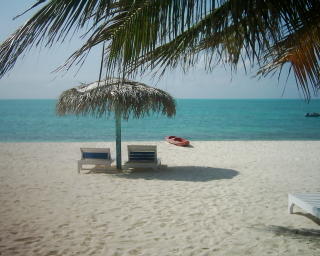
There were so many things we wanted to do. I wanted to do a few dives, try water-skiing, and Ana wanted to do some kayaking. We were quickly washing off the sand under the balcony tap, when we noticed that the little shells strewn on the sand were somehow moving about. Sure enough the shell closest to me developed a pair of legs and started hobbling around in the sand. Hermit crabs. Each with its own calcareous shell, depending upon its size. They were everywhere.
Soon it was lunchtime. The food was quite good. We had a choice of two vegetarian items, a non-vegetarian dish and there was rice or chapati. We decided to sit outside on the chair and tables laid out on the sand under the shade of the coconut trees. The dessert consisted of a tropical fruit salad which Ana dispatched with glee.

After a short nap I wanted to try some snorkelling. I had brought along my own mask and fins and was eager to explore the coral just off the beach. There was a wooden jetty extending into the sea at the end of which was a roofed platform with a couple of deck chairs for relaxing. This platform had concrete steps leading into the water. I jumped off these steps and dived to the sandy bottom about 10-
 feet down. Immediately I saw a lion fish. It had white and brown striped feather-like spines sticking out of its body, as it hovered motionless in the water. A "sting" from these spines causes excruciating pain, so I kept a respectable distance from it. There were other fish too - the blue parrotfish and damsel fish. The fish on the left is the yellow tang, another species that you can spot while snorkelling in the reefs.
feet down. Immediately I saw a lion fish. It had white and brown striped feather-like spines sticking out of its body, as it hovered motionless in the water. A "sting" from these spines causes excruciating pain, so I kept a respectable distance from it. There were other fish too - the blue parrotfish and damsel fish. The fish on the left is the yellow tang, another species that you can spot while snorkelling in the reefs.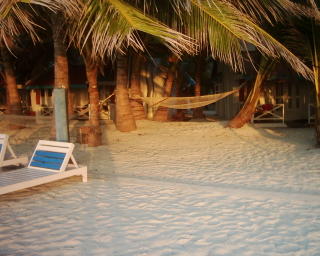
It was evening time, and I met Thomas, the manager of Agatti beach resorts. He was a personable young man and he gave me an update of planned activities which included a ride in a glass bottom boat, fishing, and a trip to three neighbouring islands.
We could try scuba at some of the fantastic spots beyond the outer reefs, but to my disappointment we could not try windsurfing because the dive master was not on-site and he was the one who owned the equiptment. I was promised that I would be able to borrow it from him even though he was not on the island, but for some reason he had locked it up in his room and there was no way to access it.
A cautionary note about alcohol. Agatti island is strictly BYOB (Bring Your Own Booze)! The only island in the Lakshadweep that sells liquor is Bangaram, the neighbouring island, which prices it accordingly. I had brought all kinds of emergency supplies of liquor and was glad to share it with staff and guests. This consisted of two other newly married couples who were in the resort, Thomas and Mark. We sat at the dry bar on the sand accross from the gangplank and guzzled Kingfisher.
We slept well that night.
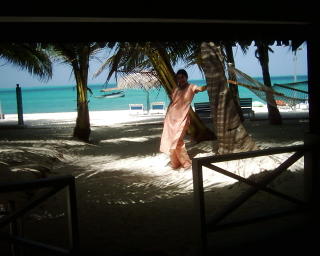
Agatti (21, February, 2005) - Next day we were taken on a glass bottom boat cruise. Part of the boat was shaded with a wooden bench extending on either side, and a small patch of glass in the center provided us a murky view of the sea bed as the boat sped along within the reef. The outer reef shielded the islands from the big waves and this kept the beaches on the island calm. Most of the seabed was tan crystalline sand, but there were outcrops of coral rock which showed up as inky blue blots on an otherwise acquamarine sea. The boat moved over these rocks and the finger coral that clothed these rocks was home to different types of fish. We also saw two or three sea turtles cruise along the boat.
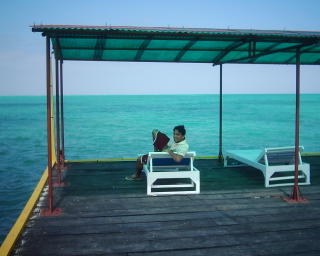
This same boat was to take us to the outer reef area for some fishing. Pasha was the man incharge of the fishing expedition.
Pasha with his reserved and calm manner represented the all-knowing fisherman to us, and we were not afraid to ask him very stupid questions about life in the islands.
He was a man of action and soon had us all holding on to the plastic fishing lines that trailed behind the boat. But even he was unable to catch any fish in the first 10 minutes. I was not too interested in catching the fish as much as observing them up close and personal, so when he suggested that we go to another spot for fishing I asked him if it was OK to head home, and he gladly complied.
Its worthwhile taking a walk on the tree shaded concrete slab of a road that goes to the village at the far end. I decided to walk for 5 km, and so far I had seen just one motorcycle and a jeep speed past me and a few men on bicycles. Now on my way back the same jeep on its way back, stopped and the driver asked if I needed a ride back to the resort. I was happ
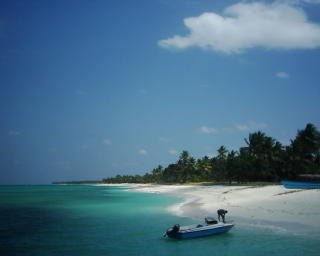 y to hop in, thus saving me a hour long walk. On the way back we spotted something on the side of the road fluttering about. It was an injured cock that was probably hit by the motorcyclist who went past before us. The driver stopped and called to the house owner. When he came out they let him know in Malayalam to make appropriate adjustments to his chicken inventory.
y to hop in, thus saving me a hour long walk. On the way back we spotted something on the side of the road fluttering about. It was an injured cock that was probably hit by the motorcyclist who went past before us. The driver stopped and called to the house owner. When he came out they let him know in Malayalam to make appropriate adjustments to his chicken inventory.I was back and Ana was up and ready to take her first lessons in snorkelling. We rented snorkelling masks for Rs. 50 for her and set out in one of the kayaks to one of the coral stations. She picked it up quickly and was soon enjoying her first underwater adventure.
It is well worth learning the four basic snorkelling skills because the sense of exhileration that comes from diving down and observing the fish swim through the colorful coral and other creatures like the moray eel from a distance of inches is only surpassed by doing an actual scuba dive.
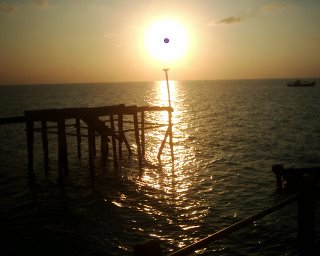
After lunch I wanted to explore the southern waters. The waters to the south had a lot more coral formations. Infact coral was like a forest there and the underwater life was also thriving. The reef was closer here and the further I went from the beach I was greeted by larger fish including yellow and blue wrasse, a few scorpion fish, a couple of morays, star fish, a parrot fish, and several others of different colors.
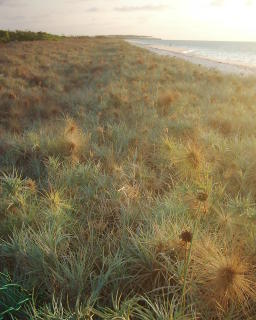
One sad thing I found though was that there was a path leading from the beach to the reef that had been cleared by the islanders walking over the coral during low tide. There were newly broken finger of coral here and washed out and powdered coral elsewhere showing the loss of underwater life where people had carelessly trampled on them. Thomas said that despite being warned about it, the islanders (mostly women) just wander accross the coral garden at low tide and go to the reef to pick fish and shells. These cowry shells by the way are themselves many times alive with creatures that live in them. But unless they are given a strong incentive to preserve these corals, this practice will continue. Only a steady stream of visitors to the islands and a monetory need to preserve these fabulous underwater resources will lead to any efforts made to curb such activities on the part of the fishermen/women. Therefore I urge you to visit the island, not just for the fun to be had here, but as an environmental initive.
Ano
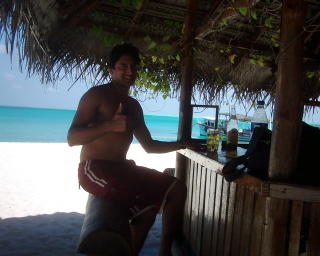 ther thing to be noted is that the Rough Guide (and even the Lonely Planet, I am told) states that only Bangaram island is open to foreigners. This is not true. Infact although I would consider the beach in Bangaram to be more beautiful to look at, there are more activities to do on Agatti, it is cheaper and in general provides a wholesome experience, with a visit to the village at the other end of the island.
ther thing to be noted is that the Rough Guide (and even the Lonely Planet, I am told) states that only Bangaram island is open to foreigners. This is not true. Infact although I would consider the beach in Bangaram to be more beautiful to look at, there are more activities to do on Agatti, it is cheaper and in general provides a wholesome experience, with a visit to the village at the other end of the island.Agatti (22, February, 2005) - Today was going to be an excursion to 3 nearby islands. We went in Pasha's boat towards Bangaram. But on the way stopped at a wreck in 30 feet water. It was a 25-foot boat and made for excellent snorkelling.
I had visited Bangaram with a friend about 2 years ago and things were pretty much unchanged. It is a smaller island, more tourist friendly, with a small bar and some boats docked in the picturesque beach. After a beer we headed to the most exciting part of the excursion - the uninhabited islands Pirelli-1 and -2.
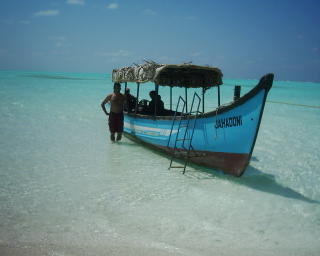
The knee deep water surrounding Pirelli has an amazing quality to it. The sunlight creates patterns on the powdery white sea bed and every click of the camera is picture perfect. The girls of course headed to the other side of the small island where a host of cowreys were there for the picking. Ana picked all sorts of shells and cowreys - large green ones, small red ones and every color in between. Most of them didnt make it far because her greed had overestimated our baggage capacity and the first to go were the plate sized clam shells.

On our way back we encountered rough seas near Agatti, so much so that ABR sent a boat to accompany us on the last leg of our careening way back.
Thoroughly sun burnt and exhausted Ana went to bed after embalming herself with coconut oil provided by Thomas, and woke up in time for a sunset walk along the beach.
Agatti (23, February, 2005) - I opted out of water skiing today and instead went diving with Mark to the Japanese Garden. Apparently Mark's boss had been comandeered by Vijay Mallya and his yatch and they were out diving somewhere. But even though he was a new divemaster, Mark knew these waters well and we set out in 30 feet water. The visibility was not too great (50-75 feet), but the underwater coral formations was spectacular. I was promised some sharks but did not see any. We surfaced after 30 minutes only to find that guys who accompanied us in the boat and had snorkelled the waters had not only seen a white tip reef shark but also a couple of dolphins!
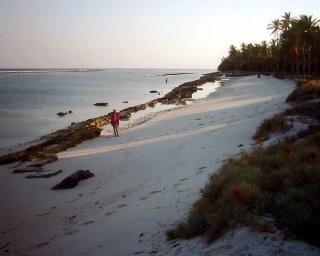
In the afternoon we took a bike ride to the village. Ana was a big hit with the kids in the village. The girls here are very bold and talkative unlike muslim communities on mainland India. They were able to communicate in English, thanks to the high school, but had to go to Kadmat for higher studies. There was a museum but we arrived late and it had already closed.
That night was our last dinner and we had a great time chatting with another couple that had arrived that day from Delhi. I was sitting chatting with the guy when Ana and his wife who had
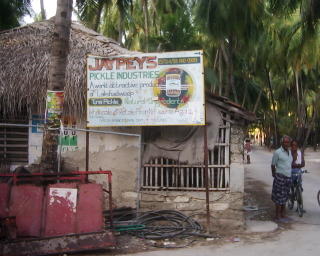 gone for a walk came back panting and wanted us to go and see something they had seen on the sand.
gone for a walk came back panting and wanted us to go and see something they had seen on the sand.We ran with torches and sure enough it was a turtle nest that had come alive with inch-long baby turtles who had just broken their shells and were marching to the sea. There were little green turtles everywhere emerging from the sand and limping off in a big column. In about 15 minutes they had all made it into the water, where most of them would perish except for a handful.
We had walked that patch of sand so many times before but were completely unaware that a foot below the ground were these eggs waiting for the right time to hatch. It was a happy end to an exciting journey, and I would recommend it to anyone interested in adventure, scuba or just a relaxing few days away from the ordinary. Also better make it fast before this place too becomes overcrowded like Goa.
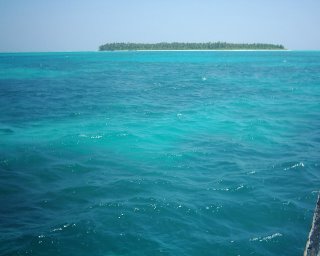
Friday, July 08, 2005
Statistics -
Number of people - 2
Number of days - 8 days
Vehicle - Ford mini - Freestar
Number of miles/km - 1515 km.
Fuel cost + rental (Hertz) - $140 + $240
Cost of stay - $380
Cost of plane tickets - $1100
Cost of food - $400
Activities (gandola, entry fees, rafting) - $460
Total cost - $2820
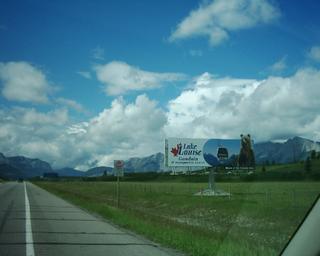
Calgary (June 24, 2005) - We arrived in Calgary by plane at 6:30 pm, rented a mini-van and headed to the Ramada Inn hotel. We drove around in circles for a while because Ani took her time polishing up her navigation skills. Dinner was at a downtown chinese restaurant close to the Bow river which was swollen and muddy due to rains the past week. Calgary downtown - small, well-organized, beautiful buildings, some amazing sky scrapers, and everything seems to be Bow-something-or-other here.
We came back and crashed, and would drive further west to Banff the next day.
Calgary (25 June, 2005) - We reached the town of Banff after a one and a half hour drive from Calgary, capital of the western Canadian province of Alberta. Highway 1 - the majestic Trans Canada Highway cuts across the rockies all the way to Vancouver BC on the Pacific.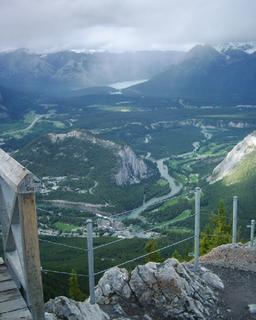
The road starts out from Calgary as a straight blue ribbon laid out on flat green lands and gentle medows and suddenly beyond the horizon the misty heights of the rocky mountains shimmer into view.
The road then meanders through the rough terrain and negotiates steep rock faces, curves around emerald lakes and dips through pine-clothed valleys until it reaches the small township of Banff.
We took the road away from Banff and towards our campsite at Two Jacks Lake.
The campsite was a room sized clearing in a forest of tall pines - one of several that lay right next to the Two Jacks lake which is a smaller lake adjacent to the Minnewanka Lake.
We used the campsite only for pitching the small 2-person tent at night (due to the high latitude there is still light here at 11 pm) and making a campfire in the iron fireplace provided on each campsite. The $7 fire-fee in addition to the $30 fee for the campsite was worth it because they provided fire-wood free. The daily fire ritual provided the necessary "camping experience" for us, and most importantly the ability to flaunt my fire-making-skill to Ani for the entire camping trip.
Although Banff was derided as being too touristy by friends, we loved it mainly because it was our first peek at the majestic rockies. The town itself was quaint with all the streets named after animals like Caribou St, Fox St. etc. Except for Main St. which was (yes) the main street that cut through town, on either side of which 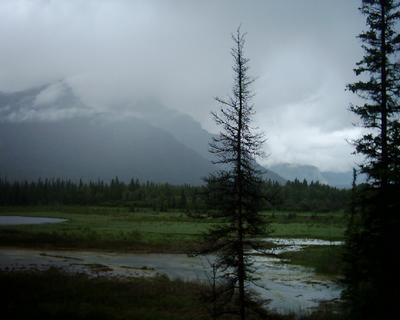 were arranged colorful boutique shops, gift shops, and a host of restaurants, surprizingly international in flavor. Ani even ate Sri-Lankan food at the food-court there, while I stuck to the Albertan favourite of beef where ever I could.
were arranged colorful boutique shops, gift shops, and a host of restaurants, surprizingly international in flavor. Ani even ate Sri-Lankan food at the food-court there, while I stuck to the Albertan favourite of beef where ever I could.
From Main St. we decided to hike the 1 mile to Basin and Spring. "The spring" was a surreal cave with a small pond filled with war sulphur water.
The hike to this place was on a mud track (frequented by horseback riders), with the road on one side and a misty marsh on the other side. The warm water trickling out of the volcanic belly of Sulphur mountain had created this marsh which actually survives the harsh winter here without freezing and is home to exotic species of plants and animals, including the rare warm water snail, which the Provincial park people take very seriously, and thanks to a written suggestion by Ani, may consider fining you for suspected mischief in the near future.
We got back to the town and visited the stepped gardens there. Ani and the spring flowers photogenically complied to my frenzied photo-taking.
The Gondola ride up to the top of the mountain was a bit further up by car and we decided to pay the $30 fee for an arial view of Banff. What we were treated to, far exceeded our expectations. From the top of the mountain (which was so cold that it warranted a hasty purchase of gloves) we could not only see the small town of Banff surrounded by silvery lakes, but all around were mountains stretching away to the far distance dappled with shafts of golden sunlight that found its way through the intermittent cloud cover. There were also the alpine goats and sheep that had walked up to the wooden steps and walking trail setup there to go even further to a vista point high up in the adjacent peak.
Banff (June 26, 2005) - I slept well in the tent; Ani did not. We set out on a hike around Minnewanka Lake and up one of the hills surrounding it on the Johnson Canyon hike. The flat blue of the lake with the background of the green and brown angular peaks of surrounding mountains provides for 360-degrees of picture perfect views. We hiked 8 miles that day and got tired. Some new muscles in my legs proclaimed their existence by inflicting pain on me with each step I took. This called for a trip to the upper hot springs where we could actually take a dip in hot water.
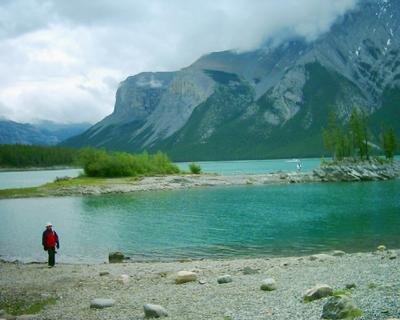 We headed towards Banff and on the way there we were greeted by some elk that had wandered onto the side of the road causing motorists to stop and take pictures. After lunch in Banff we paid a visit to the hot springs. Although we were let down by the presence of government mandated chlorine in the "sulphur springs" the 38-degree water was a panacea to our various aches and pains, and we headed back to camp. Next day would be a white water rafting trip at Golden.
We headed towards Banff and on the way there we were greeted by some elk that had wandered onto the side of the road causing motorists to stop and take pictures. After lunch in Banff we paid a visit to the hot springs. Although we were let down by the presence of government mandated chlorine in the "sulphur springs" the 38-degree water was a panacea to our various aches and pains, and we headed back to camp. Next day would be a white water rafting trip at Golden.
Golden (June 27, 2005) - Golden is further west beyond Yoho Provincial Park. We were to do a half day rafting trip down Kicking Horse river (everything is Kicking Horse in Golden). We joined a group of rafters who had already completed a milder phase of rafting down-river and were having barbeque lunch on the small beach where they had tied their 8-person rafts. After a quick lunch we were given some safety instructions that followed the north-american format of injecting gruesome humor and trivia to lighten up the drab information. We then boarded the raft and floated down river along with the rest down rapids like twin-towers, goat point, etc. There were a couple of these that bounced us a bit but most of them just spun us a bit. After the 45-minute journey the crew tried their best to sell us a second run further down river which was heralded as being even more exciting than the trip so far, but we passed on the $45 additional fee, and decided to spend it on a cable car ride at the Golden Resort out further west, which promised a social visit to a grissly in captivitiy.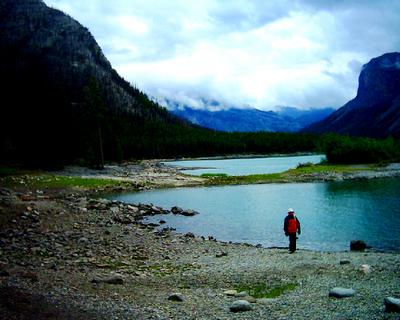
Sure enough after negotiating our way through the town of Golden and up through pine forests, we came to the resort and purchased our tickets for a ski-lift ride to the 22-acre enclosure which housed Boo, the 4 year old grissly orphan, who spent his time taking crowd-pleasing walks along the electric perimeter fence, and frequent dips in the small pond at the center of the enclosure.
After that further up in a cable car to the top of yet another mountain. But this was different. The top was almost bare and formidable looking with a ridge hike to another peak. There were scant trees and vegetation, scaly rock formations, sudden drops of several hundred feet on all sides, and snow and ice tongues on the faces of the mountain not exposed to the sun. We braved a trecherous hike to the next peak and were rewarded with surprizing vistas and a thorough lung workout in the scant air at this altitude.
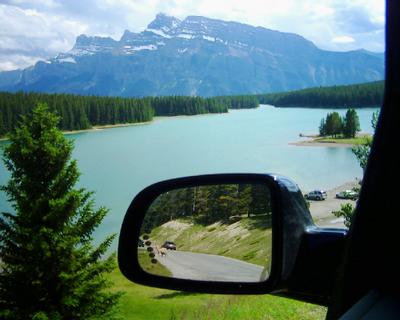 By the time we got back to the resort at the foot of the hill in the cable car it was already getting late in the evening and we were to meet Ani's cousins in Lake Louise. When Ani called them up we were made an offer which we couldnt refuse - "Do you wan to stay in the Chateau Lake Louise for the night for a discounted price of $100."
By the time we got back to the resort at the foot of the hill in the cable car it was already getting late in the evening and we were to meet Ani's cousins in Lake Louise. When Ani called them up we were made an offer which we couldnt refuse - "Do you wan to stay in the Chateau Lake Louise for the night for a discounted price of $100."
So it was back east to Lake Louise for our tryst with luxury. This five star hotel forms the archetectural jewel in the crown that is Lake Louise. Set at one end of the picturesque lake, it is both part of history and now an integral part of the landscape that lends its man-made beauty to the excess of nature around it.
Anyway, we walked in our muddied clothes into the lobby and were shown into our rooms in the old wing of the hotel. After meeting and expressing our gratitude to the cousins over a ravenously devoured dinner we exposed our campground-worn backsides to the soft, silken caress of multi-layered beds in an airconditioned room. I became unconcious. Ani for some reason couldnt sleep, perhaps to savour the luxurious feeling of lying on the bed.. I dont know.
Lake Louise (june 28, 2005) - The next morning we could not help but be perky, what with t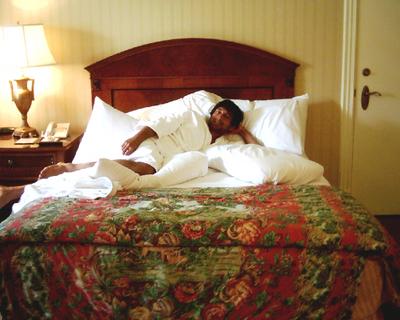 he splendor of Lake Louise spread before our eyes with the swish of parting curtains. After a tour of the hotel and a walk around the lake, we bid farewell to the cousins, and set our bearings to Jasper.
he splendor of Lake Louise spread before our eyes with the swish of parting curtains. After a tour of the hotel and a walk around the lake, we bid farewell to the cousins, and set our bearings to Jasper.
The road to Jasper is called one of the most picturesque highways in the world - The Icefield Parkway. It winds its way through fantastic mountain country and gets as close to a glacier as a highway can get. The sights that our eyes feasted on included alpine lakes like Peyto lake, Sunwapta falls, hanging glaciers and fast flowing blue-green rivers that snaked their way along the road.
We reached Jasper at the end of the day, after checking into our campsite at Wabasso which was 20 minutes south-eaast of town.
If Banff was a delightful and touristy welcome to the Rockies, then Jasper was a thrilling bear hug. Not only were the mountains taller and the valleys deeper, but there was an air of the ominous in this beautiful town set on the frontiers to adventure. We had left the security of civilization somewhere behind, and what lay before us was an invitation to the bosom of nature, but on her terms. My melodramatic exaggeration is just to convey the differences between Banff and Jasper, because, save for the couple of bear attacks the past week, the area was generally safe.
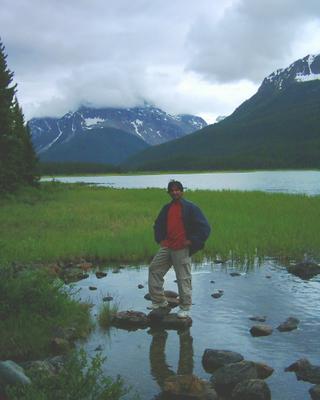 We were greeted with a rainbow beyond the railyward in Jasper. We quickly had dinner and drove back to setup camp at Wabasso. We had become good at setting up tent by now. We could setup the tent in 5 minutes, and I could make a fire that could actually be used for cooking stuff on.
We were greeted with a rainbow beyond the railyward in Jasper. We quickly had dinner and drove back to setup camp at Wabasso. We had become good at setting up tent by now. We could setup the tent in 5 minutes, and I could make a fire that could actually be used for cooking stuff on.
Jasper (June 29, 2005) - It was raining overnight off-and-on, which woke me up a couple of times with its incessant splatter on the tent roof, but I still slept better than I did in the city. Even HB had a good sleep here, so we decided to tackle the Madeline Lake hike. The helpful Provinvial park guard at the wabasso campground offered up a delightful concoction of colorful scenery, adventurous and strenuous climbs and an alpine glacier fed lake at the top, as an introduction to this hike, and we decided to test it out. Sure enough, it started out with a steady climb on a zig-zagging path through pine forests on a humid bed of muck and rocky outcrops, until we reached a large lake. Then the path followed the western bank of this lake to what looked like a landslide of huge boulders that stretched right up to the dizzy snowcapped peaks of a mountain. At this point Ani strung together a hasty mutiny, and wanted to head back. I 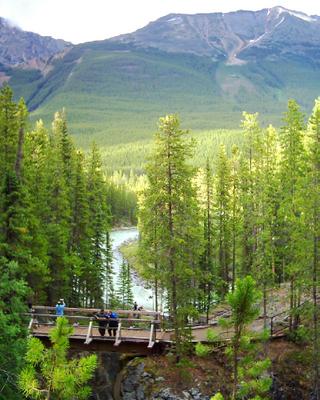 negotiated for another 15 minutes of hiking further and she was reluctantly coaxed along with a chocolate bar and some other snacks. The desolate yet breathtaking scenery beyond the sub-alpine zone that greeted our eyes was well worth the effort. The lake was a saucer of blue within a gargantual amphetheatre of rocky mountains that humbled us with its size and grandeur. We lay on the rocks, digested the scenery along with some high-fibre cereal bars, and came away fully satisfied with the artistry of mother nature.
negotiated for another 15 minutes of hiking further and she was reluctantly coaxed along with a chocolate bar and some other snacks. The desolate yet breathtaking scenery beyond the sub-alpine zone that greeted our eyes was well worth the effort. The lake was a saucer of blue within a gargantual amphetheatre of rocky mountains that humbled us with its size and grandeur. We lay on the rocks, digested the scenery along with some high-fibre cereal bars, and came away fully satisfied with the artistry of mother nature.
We lazed around Jasper town that afternoon, and Ani picked up an interesting book about wildflowers from the Friends of Jasper shop. We stopped at the information desk to verify the credentials of various wildlife we had spotted in our adventures so far. For the record these include female and male elk (one of which was a young male grazing majestically in the garden in the train depot within Jasper city limits), 3 types of squirrels or chipmunks, a noisy little (what was that?) little larger than a rat in Golden, a little brown snake in Five Lakes hike, a black bear loping along the road near the town of Field, a shaggy coyote along the highway near Jasper, several skittish white tailed deer, some sort of pheasant that lives in the barren alpine regions on mountains, and the most intriguing and inquisitive animal - the alpine marmot - a plucky (and furry) little creature the size of a cat that emits whistles when panic stricken and which we found on top of Whistler mountain the next day.
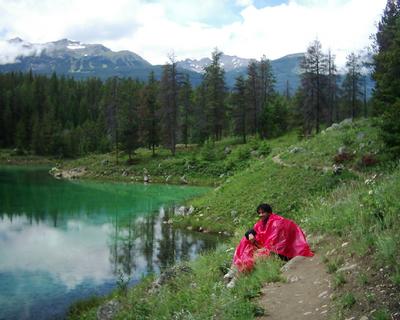 That evening we decided to just do the campsite thing, by building a fire, perhaps cooking and sleeping early. The fire was built, some eggs were boiled, a can of beans was heated, and bread was toasted, while Ani wrote some postcards and threw in some words of encouragement here and there. But she ended up eating some food which she had bought from a large fast food manufacturer. In protest I ate the food I had painstkingly cooked, not just for dinner, but also for breakfast the next day. I was rewarded with some mild intestinal tremors, but nothing serious.
That evening we decided to just do the campsite thing, by building a fire, perhaps cooking and sleeping early. The fire was built, some eggs were boiled, a can of beans was heated, and bread was toasted, while Ani wrote some postcards and threw in some words of encouragement here and there. But she ended up eating some food which she had bought from a large fast food manufacturer. In protest I ate the food I had painstkingly cooked, not just for dinner, but also for breakfast the next day. I was rewarded with some mild intestinal tremors, but nothing serious.
Jasper (June 30, 2o05) - The next day we decided to hike the 5 lakes hike. These are 5 lakes like beads on a chain, connected to each other. What makes them unique is the different shades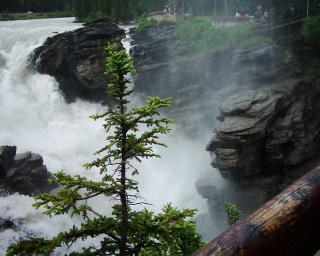 of blue green because of varying depths in each of the lakes. The greenish blue color itself is due to reflection of light off suspended sediments in the water. By this time, identifying the various wild flowers on the trial was a serious pastime for Ani and our hike was nothing more than stopping every couple of feet to earnestly stare at the minutest of plant life and fervently scanning the little book to correctly identify it. She successfully identified about 50 species of a possible 140 listed in that bible, and even a couple of other flowers (presumably "beyond the scope" of the pretentious little book) which were sumarilly denouced as "non-native species" by her.
of blue green because of varying depths in each of the lakes. The greenish blue color itself is due to reflection of light off suspended sediments in the water. By this time, identifying the various wild flowers on the trial was a serious pastime for Ani and our hike was nothing more than stopping every couple of feet to earnestly stare at the minutest of plant life and fervently scanning the little book to correctly identify it. She successfully identified about 50 species of a possible 140 listed in that bible, and even a couple of other flowers (presumably "beyond the scope" of the pretentious little book) which were sumarilly denouced as "non-native species" by her.
Nonetheless, we completed Five Rivers hike and had ample time to head over to the Jasper gondola up Whistler mountain. The mountain top here was even more bleak than the Banff and Golden one - truely alpine - with very little plant life surviving at such great altitude and subject to blasts of cold winds.
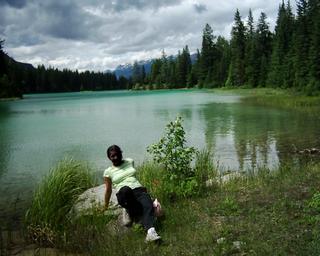 Talking of cold winds, we were one our way to a high peak from where the gondola dropped us off, picking our way on the narrow path that skirted the mountain of scree when suddenly the sky to the west became thick with dark gray clouds.
Talking of cold winds, we were one our way to a high peak from where the gondola dropped us off, picking our way on the narrow path that skirted the mountain of scree when suddenly the sky to the west became thick with dark gray clouds.
These were low clouds that were approaching us fast, accompanied by cold winds that steadily intensified in velocity, temperature and sound, until I could easily stand at a 80-degree angle by leaning into the wind. Even the alpine marmot gave up its perch atop a nearby boulder and took refuge between two rocks. We were about to go further when the high winds tore my nice red pancho into tatters. We decided to head back as the whole world turned to dark gray and it seemed like we were walking on a decapitated mountain top tossed around in a sea of gray.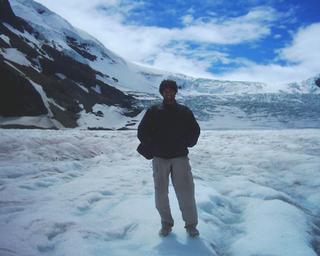
On the way down the gondola we could see snow flakes swirling in the wind. End of day-7.
Jasper (July 1, 2005) - We stopped at Athabasca falls on the way back to Lake Louise. It was the long weekend so we were not guaranteed a place in the campgrounds in Lake Louise, but we decided to take our chances.
The most unique spectacle on the most picturesque highway in the world - the Icefield Parkway - is the Columbia glacier. It is a tongue of ice that extends from the ice field and pushes its way down to the valley where, much to the gratitude of everyone is located the icefield center, strategically located to sell food, and glacier rides to thousands of tourists, including an inordinate number of Japanese tourists. Brewster owns all busses and glacier buggies in this region. Our travel companions on the glacier buggies were 50% japanese and on the way back from the glacier the comentary was in japanese. The ride itself was accross small mountains of 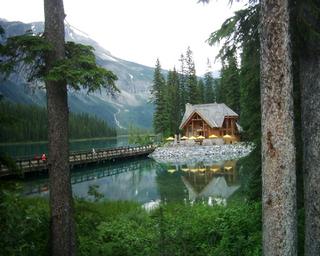 lateral moraines pushed down by the glacier and beyond was the vast ghostly white expanse of the columbia glacier. The white corrugated surface of the glacier was apparently full of crevasses or fissures in the ice that could devour whole buildings, so bright blue cones were used to cordon of the area beyond a central clearing where we were free to dance around and bump into other brightly colored tourists periodically dumped here by the wealthy company.
lateral moraines pushed down by the glacier and beyond was the vast ghostly white expanse of the columbia glacier. The white corrugated surface of the glacier was apparently full of crevasses or fissures in the ice that could devour whole buildings, so bright blue cones were used to cordon of the area beyond a central clearing where we were free to dance around and bump into other brightly colored tourists periodically dumped here by the wealthy company.
We headed back after our allotted time on the glacier was over, and after eagerly devouring interesting facts and other trivia about glaciers in the museum below (which I have mostly forgotten by now), we headed off to Lake Louise.
We were lucky to get a no-fire campsite in Lake Louise itself, and had enough time to go to Takakaw falls. It was getting late in the evening on our way back, but we wanted to check out Moraine lake. Although we spent only 10 minutes here because it was already 10 pm, but still this lake made a sombre impression on us. Its apt description as the "beautiful and depressing?? lake" surrounded by mountains, holds true.
Yoho Provincial Park (July 2, 2005) - We made a hasty trip to Emerald lake, at the center of Yoho Provincial park. This is a very scenic lake with reflections of mountains in it dark tranquil waters, and the few colorful shacks that color its water front like any number of paintings that attempt to capture that solemn beauty of mountainous lakes.
Ani actually found a couple of orchids here which was the highlight of the short hike for her. My favourite wild flower - the orange paintbrush - was also in abundance here.
The colorful vista of emerald lake was a fitting farewell to our fun-filled road-trip to the Rockies. We drove back to Calgary airport and made up our minds to revisit this part of the world at the next opportunity we get.